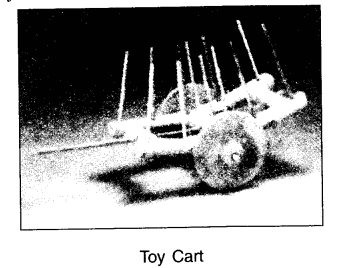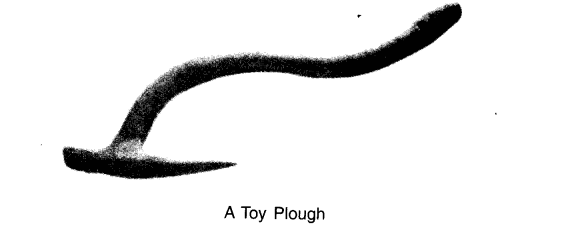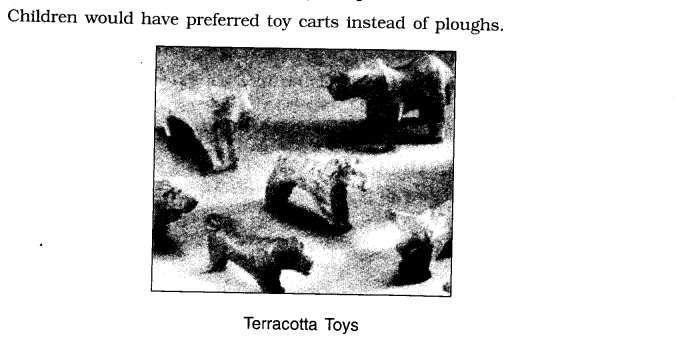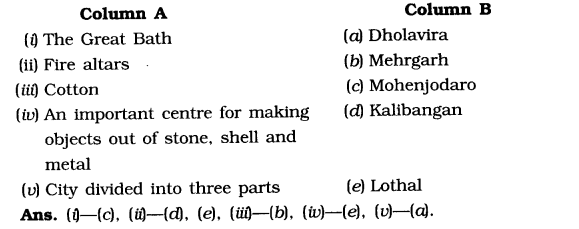NCERT Solutions for Class 6 Social Science History Chapter 4 In the Earliest Cities
1. How do archaeologists know that cloth was used in the Harappan civilization?
Answer:
- According to archaeologists cotton was probably grown in Mehrgarh about 7,000 years ago.
- Actual pieces of cloth were found attached to the lid of a silver vase and some copper objects at Mohenjodaro.
- Archaeologists have also found spindle whorls, made of terracotta and faience. These were used to spin thread.
- We also have indirect evidence to show how cloth was decorated. For example, a stone statue of an important man found at Mohenjodaro shows him wearing an embroidered garment.
2. Match the columns:
Answer:

3. Why were metals, writing, the wheel and the plough important for the Harappans?
Answer:
- Metals: The Harappan made copper tools. They also made ornaments of gold and silver.
- Writing: Writing was very important for the Harappans. There were scribes, people who knew how to write. Scribes helped prepare the seals and perhaps wrote on other materials that have not survived.
- Wheel: The Harappans used the wheel in carts. They also used the wheel in spinning. The wheel was used by potters to make or shape pots and other things.
- Plough: Plough was used to prepare the land for farming by the Harappans.
4. Make a list of all the terracotta toys shown in the lesson. Which do you think children would have enjoyed playing with the most?
Answer:
The terracotta toys shown in the lesson are:



5. Make a list of what the Harappans ate, and put a tick mark against the things you eat today.
Answer:

Note:
Depending upon where you live, and with the help of your teacher, select the food items eaten by you.
6. Do you think that the life of farmers and herders who supplied food to the Harappan cities was different from that of the farmers and herders you read about in chapter 3? Give reasons for your answer.
Answer:
Yes, I think that the life of farmers and herders who supplied food to the Harappan cities was different from that of the farmers and herders, I read about in the last lesson.
I can give the following reasons for my answer:
- We know from remains of plants and bones of animals that the contemporary farmers and herders of the Harappans grew more cereals and collected many types of fruits and other things. They grew wheat, barley, pulses, peas, rice, sesame, linseed and mustard.
- A new tool, the plough, was used to dig the earth for turning the soil and sowing seeds by the farmers of the Harappan times while real ploughs, which were probably made of wood, have not survived, toy models have been found.
- As the Harappans’ region did not receive heavy rainfall, some form of irrigation might have been used. This means that water was stored and supplied to the fields when the plants were growing.
- The Harappans reared cattle: Sheep, goat and buffalo. Water and pastures were available around settlements. However, in the dry summer months, large herds of animals were probably taken to greater distances in search of water and grass by the farmers and herders, mentioned in the last lesson. But the Harappan age people also collected fruits like her, caught fish and hunted wild animals like the antelope.
- The farmers and herders of the Indus Valley had relations with better or more civilized people who had better houses, roads, drain-system, knowledge of writing, and cities. The farmers and herders of the last chapter (or stone age) did not know the use of metals.
7. Describe three important buildings in your city or village. Are they located in a special part of the settlement (e.g. the centre)? What are the activities that take place in these buildings?
Answer:
In our city (or village) the following three important buildings are located:
- Community Hall or Gram Panchayat Bhawan or Municipal Committee Bhawan
- School Building
- Hospital
-
Temple or Mosque or Church or Gurudwara
(Any three groups or points.)
The following activities take place in these buildings respectively:
-
Community Hall.
Marriage Parties or Public Functions.
Gram Panchayat Bhawan. In this Bhawan (Building) Panchayat holds its meetings and discusses our village problems.
Municipal Committee Bhawan. In this Bhawan city’s elected members meet under a chairman and discuss problems of the city. - School Building. In this building, education is provided to boys and girls of our village or city.
- Hospital. Here ill people or patients come and consult doctors, compounders or nurses as per their diseases or requirements.
- Temple or Mosque or Church or Gurudwara. People come and participate in prayer (or Namaz) according to their own religion and faith. (Any three points.)
8. Are there any old buildings in your locality? Find out how old they are and who looks after them.
Answer:
Yes, there are some old buildings in our locality. These buildings are looked after by a government department. The name of this department is the Archaeological Survey of India.
I. Multiple Choice Questions
Choose the correct option to complete the statements given below:
(i) The Great Bath has been discovered in ……………….
(a) Lothal
(b) Harappa
(c) Mohenjodaro
(d) Kalibangan.
(ii) Most cities had the western part ………… and …………..
(a) smaller, higher
(b) smaller, lower
(c) larger, higher
(d) larger, lower.
(iii) Which of these groups of people did not usually live in cities, but the countryside?
(a) rulers
(b) craftspersons
(c) farmers and herders
(d) scribes
(iv) The alloy of tin and …………. is called bronze.
(a) zinc
(b) copper
(c) gold
(d) platinum.
(v) The city of Lothal was situated beside a river which was a tributary of
(a) Ganga
(b) Sabarmati
(c) Narmada
(d) Kaveri.
(vi) What caused the end of Harappan civilization?
(a) Deforestation
(b) Rulers lost control
(c) Flooding
(d) Reasons unknown to us; but probably those listed in the other three options.
Answer:
(i) – (c), (ii) – (a), (iii) – (c), (iv) – (b), (v) – (b), (vi) – (d).
II. Fill in the Blanks
Fill in the blanks with appropriate words to complete each sentence:
- The western part of Harappan cities, which was usually smaller but higher, has been referred to as the ……………..
- The eastern part of Harappan cities, which was usually larger but lower, has been referred to as the ……………
- The Great Bath was made water tight with a layer of………………….
- Scribes were people who knew how to ………………
- Metals like gold and silver were used to make …………… and ………….
- Most Harappan seals are made of………………
- Archaeologists have found spindle wheels, made of terracotta and ………………….
- Spindle whorls were used to …………….
- The Harappans got copper from the present day…………………
- A tool called……….. was used to dig the earth for turning the soil and planting seeds.
- …… must have been used by farmers since the region of Harappa did not receive heavy rainfall.
- Sealings are impressions of seals on ……………
Answer:
- Citadel
- lower town
- natural tar
- write
- ornaments, vessels
- stone
- faience
- spin thread
- Rajasthan
- plough
- Irrigation
- clay.
III. True/False
State whether these sentences are true (T) or false (F).
- The bricks in Harappa were laid in an interlocking pattern and that made the walls strong.
- Usually, the special buildings were created in the lower town.
- The houses of Harappa were poorly built.
- Harappan seals were made of metal
- People knew about cotton much before Harappa.
- All raw materials were available locally.
- The hunter-gatherers used some form of irrigation.
- The rainfall,was low in the Harappa region.
- We are not sure about what caused the end of the Harappari civilization.
Answer:
- T
- F
- F
- F
- T
- F
- F
- T
- T.
IV. Matching Skill
Match the items in column A correctly with those given in column B.

V. Very Short Answer Type Questions
1. When and how was the site of Harappa first encountered? [Imp.]
Answer:
Around a hundred and fifty years ago, when railway lines were being laid in Punjab, engineers stumbled upon the site of Harappa.
2. How old are Harappa cities believed to be?
Answer:
Harappa and other such cities are believed to have developed 4700 years ago.
3. What was the citadel?
Answer:
The western part of most cities was smaller but higher, described as ‘citadel’ by archaeologists.
4. Give some important features of the Great Bath. [V. Imp.]
Answer:
The Great Bath was lined with bricks, Coated with plaster, and made water tight with natural tar.
5. Name two cities which had fire altars.
Answer:
Lothal and Kalibangan were cities with fire altars.
6. What were the three mayor categories of people in a Harappan city?
Answer:
In Harappan cities, rulers, Crafts-persons and scribes were the three categories of people.
7. What were objects in Harappan cities made of?
Answer:
Most Harappan objects were made of stone, shell and metal.
8. How do we know that cotton was grown in Mohenjodaro? [V. Imp.]
Answer:
Archaeologists have found pieces of cloth with vases and other objects in Mohenjodaro. So cotton must have been grown.
9.Who was a ‘specialist’ in Harappan context? –
Answer:
A specialist was one who was trained to do one kind of work, e.g. cutting stone, polishing beads, or carving seals.
10. Define ‘raw material.
Answer:
Raw materials are substances that are either found naturally or produced by farmers or herders.
11. Name some foreign countries from where raw materials were imported.
Answer:
Raw materials were imported from Oman, Afghanistan, Iran, etc.
12. What was the use of the plough? [V. Imp.]
Answer:
A plough was used to dig the earth for turning the soil and planting seeds.
13. Give one point of difference between Dholavira and other Harappan cities.
Answer:
Unlike other Harappan cities which were divided into two parts, Dholavira was divided into three.
14. Where did people move to from Sind?
Answer:
People moved into newer and smaller settlements to the east and the south.
VI. Short Answer Type Questions
1. Describe the two parts of a typical Harappan city. [V. Imp.]
Answer:
A Harappan city was usually divided into two or more parts. The part to the west was smaller but higher. It is called ‘citadel’. The part to the east was larger but-lower. Archaeologists call it the lower town.
2. How were bricks laid in houses of Harappan cities?
Answer:
Bricks were so well made that they have lasted for thousand of years. They were laid in an interlocking pattern and this made the walls strong. Many of these bricks were taken away by engineers about a hundred and fifty years ago.
3. Describe the drains of the cities. [V. Imp.]
Answer:
Most cities had covered drains. They were laid out carefully in straight lines. Each drain had a gentle slope. Thus, water could flow easily through it. Drains in houses were connected to those on the streets and smaller drains led to bigger ones.
4. Write a short note on the craft practised by Harappan.
Answer:
Harappan objects were made of stone, shell and metal. Copper and bronze were used to make tools, weapons, ornaments and vessels. Gold and silver were used to make ornaments and vessels. Harappans also made stone seals. They made pots with beautiful black designs.
5. Where did the Harappan get the raw materials from?
Answer:
The Harappans got the raw materials from various places. They got copper probably from present-day Rajasthan, and also from Oman. Tin was brought from Afghanistan and Iran. Gold was brought may be from Karnataka. Precious stones were brought from Gujarat, Iran and Afghanistan.
6. Write a short note on the city of Lothal. [V. Imp.]
Answer:
Lothal was a city on the banks of a tributary of the Sabarmati. It was an important centre for making stone, shell and metal objects. There was a store house in the city. Fire altars have been found here.
VII. Long Answer Type Questions
1. Describe the people of Harappan cities. [V. Imp.]
Answer:
There were three basic occupations of people living in Harappan cities.
(i) They planned the construction of special buildings in the city.They probably sent people to distant lands to get raw material. They kept the most valuable objects for themselves.
(ii) Scribes were people who knew how to write. They prepared the seals.
(iii) Crafts-persons. People who made all kinds of things were called Crafts- persons.
Besides these three categories, there were farmers and herders who lived outside the city and provided food to the people.
2. Write a short note on farming methods and rearing done by Harappan farmers and herders.
Answer:
(i) Harappans grew wheat, barley, pulses, peas, rice, sesame, linseed, and mustard. A new tool called plough was used to dig earth for turning the soil and planting seeds. Due to little rainfall, a method of irrigation was probably used.
(ii) The Harappan reared cattle, sheep, goat, and buffalo. Water and pastures were present around many sites. People collected fruits like ‘ber’, caught fish and hunted wild animals.
3. What could have been the possible reasons behind the end of the Harappan civilization? [V. Imp.]
Answer:
The Harappan civilization suddenly seems to have started to end, around 3900 years ago. People stopped living in many cities. Writing, seals and weights became ‘extinct’. Raw materials were now rarely imported.
Some scholars suggest that this happened due to the drying of rivers. Some others have explained it with deforestation. In some areas there were floods. The floods could have been a reason for the end.
Rulers might also have lost control. Consequently, People abandoned sites in Sind and Punjab and moved to newer, smaller settlements to the east and the south.
NCERT Solutions for Class 6 Social Science – History
- Chapter 1 What, Where, How and When?
- Chapter 2 On The Trial of the Earliest People
- Chapter 3 From Gathering to Growing Food
- Chapter 4 In the Earliest Cities
- Chapter 5 What Books and Burials Tell Us
- Chapter 6 Kingdoms, Kings and an Early Republic
- Chapter 7 New Questions and Ideas
- Chapter 8 Ashoka, The Emperor Who Gave Up War
- Chapter 9 Vital Villages, Thriving Towns
- Chapter 10 Traders, Kings and Pilgrims
- Chapter 11 New Empires and Kingdoms
- Chapter 12 Buildings, Paintings, and Books